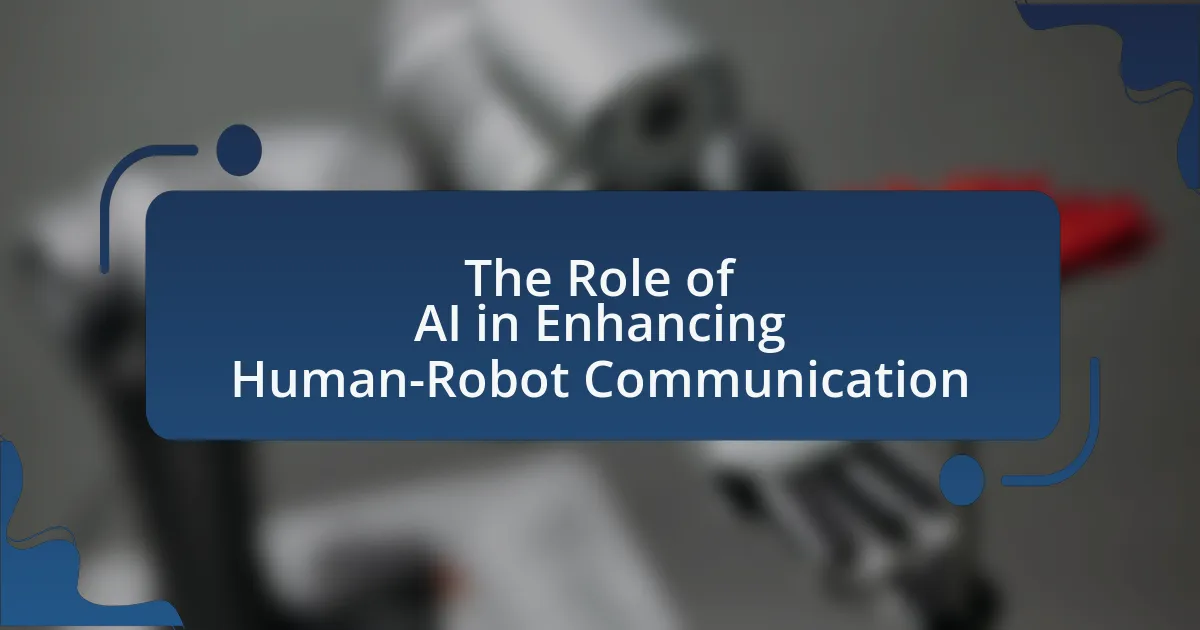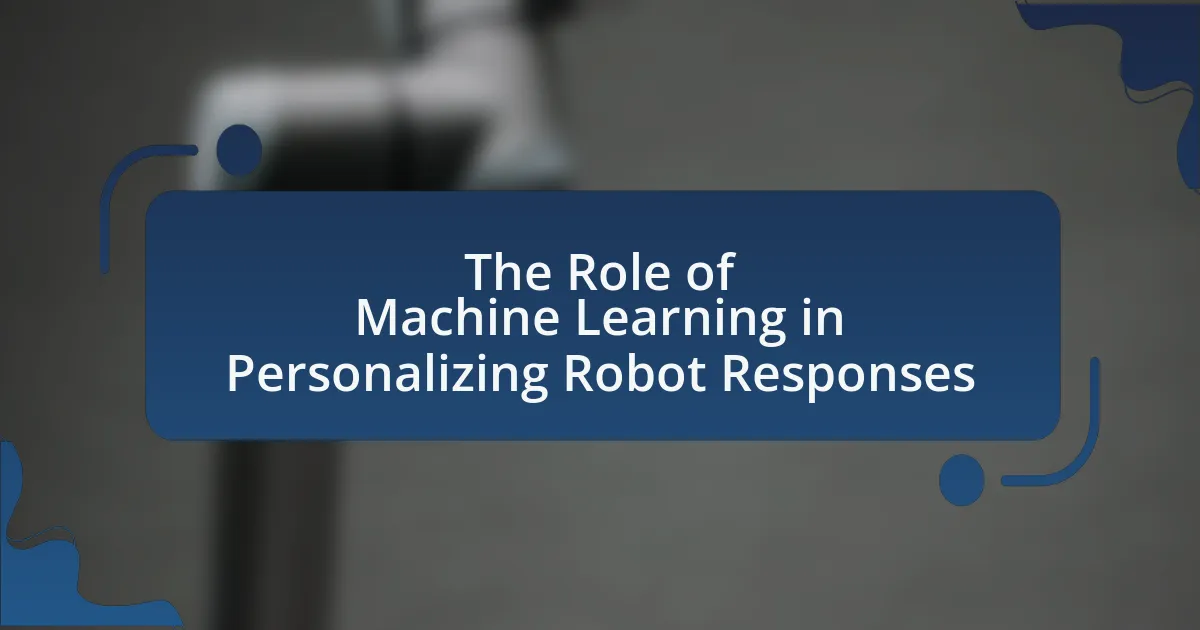Cultural factors play a crucial role in robot acceptance, influencing how individuals and communities perceive and interact with robotic technologies. This article examines the impact of societal norms, values, and beliefs on attitudes toward robots, highlighting key cultural dimensions such as individualism versus collectivism, uncertainty avoidance, and power distance. It discusses how these cultural values shape perceptions of robots, the implications for robot design and functionality, and strategies for fostering acceptance across diverse cultural contexts. Understanding these cultural insights is essential for improving robot integration and user engagement in various societies.

What are Cultural Factors in Robot Acceptance?
Cultural factors in robot acceptance refer to the societal norms, values, beliefs, and practices that influence how individuals and communities perceive and interact with robots. These factors can significantly affect attitudes toward technology, shaping whether people view robots as helpful tools or potential threats. For instance, research indicates that cultures with high uncertainty avoidance, such as Japan, may exhibit more cautious attitudes toward robots, while cultures that embrace innovation, like the United States, may show greater acceptance. Additionally, collectivist societies may prioritize the impact of robots on community welfare, whereas individualistic cultures may focus on personal benefits. This cultural context is crucial in understanding the varying levels of acceptance and integration of robots across different regions and societies.
How do cultural values influence perceptions of robots?
Cultural values significantly influence perceptions of robots by shaping attitudes towards technology and its integration into daily life. For instance, in collectivist cultures, where community and social harmony are prioritized, robots may be viewed as beneficial tools that enhance group productivity and cooperation. Conversely, in individualistic cultures, where personal autonomy is emphasized, robots might be perceived as threats to job security or personal privacy. Research by Hofstede indicates that cultural dimensions, such as uncertainty avoidance and power distance, further affect how different societies accept and interact with robotic technologies. For example, countries with high uncertainty avoidance may exhibit skepticism towards robots, preferring human interaction over automated systems.
What specific cultural values impact robot acceptance?
Cultural values such as individualism versus collectivism, uncertainty avoidance, and power distance significantly impact robot acceptance. Individualistic cultures, which prioritize personal autonomy and self-expression, tend to embrace robots as tools for enhancing personal efficiency. In contrast, collectivist cultures may view robots through the lens of social harmony and community benefit, leading to cautious acceptance. Uncertainty avoidance influences how societies react to new technologies; cultures with high uncertainty avoidance may resist robots due to fear of the unknown, while those with low uncertainty avoidance are more open to experimentation. Power distance affects perceptions of authority and hierarchy; in cultures with high power distance, robots may be accepted as extensions of authority, whereas in low power distance cultures, there may be skepticism about robots replacing human roles. These cultural dimensions shape attitudes towards technology adoption and integration in daily life.
How do cultural norms shape attitudes towards technology?
Cultural norms significantly shape attitudes towards technology by influencing perceptions of its utility, safety, and ethical implications. For instance, in collectivist cultures, technology may be viewed as a tool for enhancing community welfare, leading to more positive attitudes towards collaborative technologies. Conversely, in individualistic cultures, technology might be seen as a means for personal achievement, which can foster skepticism towards technologies perceived as intrusive. Research by Hofstede indicates that cultural dimensions, such as uncertainty avoidance and power distance, directly affect how societies adopt and adapt to new technologies, demonstrating that cultural context is crucial in understanding technology acceptance.
Why is understanding cultural context important for robot acceptance?
Understanding cultural context is crucial for robot acceptance because it shapes individuals’ perceptions, attitudes, and behaviors towards technology. Different cultures have varying beliefs, values, and norms that influence how people interact with robots; for instance, in collectivist societies, robots may be viewed as extensions of community and family, while in individualistic cultures, they might be seen as tools for personal efficiency. Research indicates that cultural dimensions, such as uncertainty avoidance and power distance, significantly affect technology acceptance models, highlighting that robots designed with cultural sensitivity are more likely to be embraced by users.
What role does cultural identity play in technology adoption?
Cultural identity significantly influences technology adoption by shaping individuals’ perceptions, attitudes, and behaviors towards new technologies. For instance, research indicates that cultural values, such as collectivism versus individualism, affect how communities embrace technological innovations. In collectivist cultures, technology adoption may be driven by group consensus and social norms, while individualistic cultures may prioritize personal benefits and autonomy in technology use. A study by Venkatesh et al. (2012) highlights that cultural dimensions, including uncertainty avoidance and power distance, directly impact users’ acceptance of technology, demonstrating that cultural identity is a critical factor in determining the rate and manner of technology adoption.
How can cultural misunderstandings affect robot integration?
Cultural misunderstandings can significantly hinder robot integration by creating barriers to user acceptance and effective interaction. For instance, if a robot’s design or behavior does not align with cultural norms or values, users may perceive it as intrusive or inappropriate, leading to resistance in adopting the technology. Research indicates that cultural dimensions, such as individualism versus collectivism, can influence how people perceive and interact with robots, affecting their willingness to accept robotic assistance in various settings. A study by Hofstede (2011) highlights that cultures with high uncertainty avoidance may be less receptive to robots that exhibit unpredictable behaviors, thereby complicating integration efforts.

What are the Key Cultural Dimensions Affecting Robot Acceptance?
Key cultural dimensions affecting robot acceptance include individualism versus collectivism, uncertainty avoidance, power distance, and masculinity versus femininity. Individualistic cultures, such as the United States, tend to embrace technology and innovation, leading to higher acceptance of robots. In contrast, collectivist cultures, like Japan, may prioritize social harmony and human relationships, influencing their acceptance of robots differently.
Uncertainty avoidance plays a significant role; cultures with high uncertainty avoidance, such as Greece, may resist robots due to fear of the unknown, while those with low uncertainty avoidance, like Sweden, may be more open to technological advancements. Power distance also affects acceptance; societies with high power distance may view robots as tools for authority, while low power distance cultures may see them as equals or partners. Lastly, masculinity versus femininity influences attitudes toward technology, with masculine cultures often favoring competitive and assertive uses of robots, whereas feminine cultures may focus on collaborative and nurturing applications.
These dimensions are supported by research, such as Hofstede’s cultural dimensions theory, which provides empirical evidence on how cultural values shape attitudes toward technology and innovation.
How does individualism versus collectivism influence robot acceptance?
Individualism versus collectivism significantly influences robot acceptance, as individualistic cultures tend to prioritize personal autonomy and innovation, leading to a higher acceptance of robots as tools for personal enhancement. In contrast, collectivist cultures emphasize group harmony and social roles, which may result in skepticism towards robots that could disrupt traditional social structures. Research by Hofstede indicates that countries with high individualism, such as the United States, show greater openness to technology, including robots, while collectivist societies, like Japan, may adopt robots more cautiously, focusing on their integration into social contexts. This cultural framework shapes perceptions and acceptance levels of robotic technologies across different societies.
What are the implications of individualistic cultures on robot use?
Individualistic cultures tend to promote the use of robots that enhance personal autonomy and self-expression. In these cultures, individuals prioritize personal goals and achievements, which can lead to a preference for robots that assist in personal tasks, such as home automation or personal assistants, rather than robots designed for collective or communal tasks. Research indicates that in individualistic societies, there is a higher acceptance of technology that supports individual needs, as seen in studies like “Cultural Differences in Acceptance of Robots” by H. K. Lee and J. H. Kim, which found that individuals from individualistic cultures are more likely to embrace robots that facilitate personal convenience and efficiency. This cultural inclination shapes the design and functionality of robots, emphasizing user-centered features that align with personal preferences and lifestyles.
How do collectivist cultures perceive robots differently?
Collectivist cultures perceive robots as extensions of community and social harmony, emphasizing their role in enhancing group welfare rather than individual autonomy. In these cultures, robots are often viewed positively when they contribute to collective tasks, support social interactions, or assist in caregiving roles, reflecting the cultural value placed on interdependence. Research indicates that in collectivist societies, such as Japan and South Korea, there is a greater acceptance of robots in domestic and healthcare settings, as they align with the cultural emphasis on family and community support. This contrasts with individualistic cultures, where robots may be seen more as tools for personal efficiency.
What impact does uncertainty avoidance have on robot acceptance?
Uncertainty avoidance significantly impacts robot acceptance by influencing individuals’ willingness to embrace new technologies. Cultures with high uncertainty avoidance tend to prefer established norms and practices, leading to skepticism towards robots and automation. For instance, research indicates that individuals from high uncertainty avoidance cultures, such as Japan and Greece, exhibit greater resistance to adopting robots in everyday tasks compared to those from low uncertainty avoidance cultures like the United States and Sweden. This resistance is often rooted in fears of the unknown and potential job displacement, which are more pronounced in societies that prioritize stability and predictability.
How do cultures with high uncertainty avoidance react to robots?
Cultures with high uncertainty avoidance tend to exhibit skepticism and resistance towards robots. This reaction stems from a strong preference for structured environments and clear guidelines, which robots may disrupt. Research indicates that individuals in these cultures often prioritize predictability and control, leading to apprehension about the unpredictability associated with robotic technology. For instance, a study by Hofstede (2001) highlights that societies with high uncertainty avoidance, such as Japan and Greece, are more likely to question the reliability and safety of robots, resulting in slower acceptance rates compared to cultures with lower uncertainty avoidance.
What strategies can mitigate concerns in high uncertainty avoidance cultures?
Strategies that can mitigate concerns in high uncertainty avoidance cultures include providing clear guidelines, fostering open communication, and ensuring consistent support. High uncertainty avoidance cultures, characterized by a strong preference for predictability and stability, benefit from structured environments where expectations are well-defined. For instance, organizations can implement detailed protocols and training programs that outline the use of robots, thereby reducing anxiety associated with unfamiliar technology. Additionally, encouraging dialogue between stakeholders can help address fears and misconceptions, as seen in studies where participatory approaches led to increased acceptance of technological innovations. Consistent support from leadership and ongoing education about the benefits and functionalities of robots further reinforces trust and reduces resistance, as evidenced by research indicating that informed users are more likely to embrace new technologies.

How Can Cultural Insights Improve Robot Design and Implementation?
Cultural insights can significantly enhance robot design and implementation by ensuring that robots align with the values, norms, and expectations of diverse user groups. Understanding cultural preferences allows designers to create robots that are more intuitive and acceptable to users, thereby increasing user engagement and satisfaction. For instance, research indicates that robots designed with cultural considerations, such as communication styles and social behaviors, are more likely to be embraced in specific regions. A study by K. H. Lee et al. (2020) published in “International Journal of Social Robotics” found that culturally tailored robots improved user interaction and trust, demonstrating that cultural insights directly influence the effectiveness of robotic systems in various environments.
What design considerations should be made for different cultures?
Design considerations for different cultures include understanding cultural values, communication styles, and aesthetic preferences. For instance, cultures that prioritize collectivism may favor robots that promote teamwork and social interaction, while individualistic cultures might prefer robots that enhance personal efficiency. Additionally, color symbolism varies across cultures; for example, white signifies purity in some cultures but mourning in others. Research indicates that culturally tailored designs improve user acceptance and satisfaction, as seen in studies like “Cultural Influences on Human-Robot Interaction” by K. K. Lee and J. A. K. Lee, which highlights the importance of aligning robot functionalities with cultural expectations to enhance acceptance.
How can cultural preferences shape robot functionality?
Cultural preferences can significantly shape robot functionality by influencing design, interaction styles, and task prioritization. For instance, in cultures that value collectivism, robots may be designed to facilitate group activities and enhance social interactions, while in individualistic cultures, robots might focus on personal assistance and autonomy. Research by Hofstede indicates that cultural dimensions, such as power distance and uncertainty avoidance, directly affect technology acceptance and usage patterns. This means that robots in high power distance cultures may be programmed to exhibit more hierarchical behaviors, while those in low power distance cultures may prioritize egalitarian interactions. Thus, understanding cultural preferences is essential for developing robots that align with user expectations and enhance acceptance.
What are the best practices for culturally sensitive robot design?
The best practices for culturally sensitive robot design include understanding cultural norms, involving diverse stakeholders in the design process, and ensuring adaptability to various cultural contexts. Understanding cultural norms allows designers to create robots that respect local customs and values, which is crucial for acceptance. Involving diverse stakeholders, such as community members and cultural experts, ensures that multiple perspectives are considered, leading to more inclusive designs. Additionally, ensuring adaptability allows robots to modify their behavior or appearance based on cultural context, enhancing user comfort and acceptance. These practices are supported by research indicating that culturally aware designs significantly improve user interaction and satisfaction with robotic systems.
How can organizations effectively engage with diverse cultural groups?
Organizations can effectively engage with diverse cultural groups by implementing culturally responsive strategies that prioritize understanding and respect for different cultural values and practices. This involves conducting thorough research to identify the unique characteristics and needs of each cultural group, which can enhance communication and foster trust. For instance, a study by the Pew Research Center found that organizations that tailor their outreach efforts to align with cultural norms see higher engagement rates. Additionally, involving representatives from diverse cultural backgrounds in decision-making processes ensures that their perspectives are integrated, leading to more inclusive and effective engagement strategies.
What strategies can enhance communication with culturally diverse users?
To enhance communication with culturally diverse users, employing strategies such as active listening, cultural sensitivity training, and the use of clear, simple language is essential. Active listening fosters understanding by ensuring that users feel heard and valued, which is crucial in multicultural interactions. Cultural sensitivity training equips communicators with the knowledge to recognize and respect different cultural norms and values, thereby reducing misunderstandings. Additionally, using clear and simple language minimizes the risk of miscommunication, as complex jargon may not be universally understood. These strategies are supported by research indicating that effective communication in diverse settings leads to improved user satisfaction and engagement, as highlighted in studies on intercultural communication effectiveness.
How can feedback from different cultures inform robot development?
Feedback from different cultures can inform robot development by providing insights into diverse user needs, preferences, and ethical considerations. Cultural feedback helps developers understand how social norms and values influence the acceptance and functionality of robots in various contexts. For instance, research indicates that in collectivist cultures, robots designed for teamwork and collaboration are more readily accepted, while individualistic cultures may prefer robots that enhance personal efficiency. This understanding is supported by studies such as “Cultural Influences on Human-Robot Interaction” by K. K. Lee and M. A. K. Kwan, which highlight how cultural dimensions shape user expectations and interactions with technology. By integrating this feedback, developers can create robots that are more culturally relevant and effective, ultimately improving user acceptance and satisfaction.
What are practical tips for fostering robot acceptance across cultures?
Practical tips for fostering robot acceptance across cultures include promoting cultural sensitivity, engaging in community dialogue, and providing education about robotics. Cultural sensitivity involves understanding and respecting the values and beliefs of different cultures, which can help tailor robot functionalities to meet specific cultural needs. Engaging in community dialogue allows for open discussions about the benefits and concerns related to robots, fostering trust and acceptance. Education about robotics, including demonstrations and workshops, can demystify technology and highlight its advantages, leading to increased acceptance. Research indicates that cultural factors significantly influence technology acceptance, as seen in studies like “Cultural Influences on Technology Acceptance” by Venkatesh et al., which emphasizes the importance of aligning technology with cultural norms.





